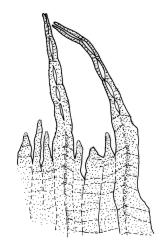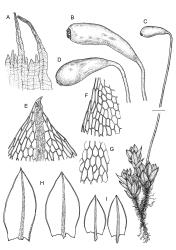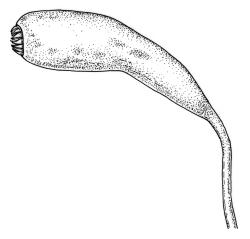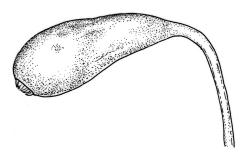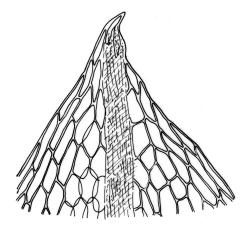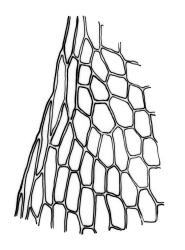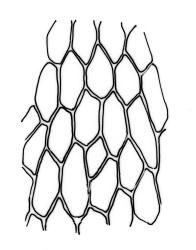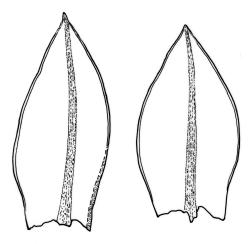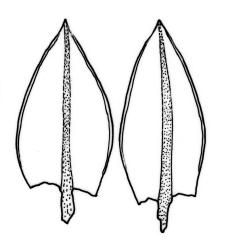Plants brown-green, forming compact turves or tufts. Stems red-brown, to c. 14 mm, branching by subperichaetial innovations, beset below with dark brown, coarsely papillose rhizoids, in cross-section with 1–2 layers of firm-walled cortical cells and a distinct and large central strand. Leaves moderately comose in fertile material, ± evenly spaced on sterile stems and innovations, erect-spreading when moist and ± spiralled around stem when dry, broadly ovate or oblong-ovate, acute, mostly 2.0–3.0 × c. 1.0 mm in comae, smaller (c. 1.0 mm) on lower stem and on innovations, weakly concave, not pigmented at base, entire, narrowly bordered, not decurrent, with margins plane or ± recurved below; upper laminal cells rhombic-hexagonal or oblong, rather thin-walled, 69–90 × 24–27 µm and 2.3–3.5:1, becoming longer and more oblong below; marginal cells forming a border of 2–3 rows of ± linear cells at mid leaf and extending ± to apex. Costa brown, rather stout, mostly percurrent, occasionally excurrent to form a short mucro. Brood bodies (including tubers) absent.
Synoicous. Perichaetia terminal, but usually overtopped by innovation, often several per plant. Setae to c. 30 mm, curved just below capsule, red-brown; capsules ± horizontal to weakly cernuous when moist, becoming suberect when dry, narrowly pyriform, 3–5 mm long, with a distinct neck c. half the capsule length, and a ± oblique and narrow mouth; operculum conic and apiculate. Exostome teeth yellow, hyaline and baculate near apex; endostome segments well developed, narrowly perforate; cilia mostly 3, often only short projections of basal membrane, sometimes longer (to c. ¼ –⅓ the height of segments) and truncate. Spores 21–30 µm.
Ochi 1973, fig. 1; Seppelt 2004, fig. 41.
NI: Wellington (Mt Ruapehu); SI: Nelson (Winter Peak, Mt Owen), Marlborough (Tapuaenuku), Canterbury (Temple Basin, Broken River, Porters Pass), Otago (Naseby). Reported from M by Seppelt (2004).
Apparently austral. Reported from South America by Ochi (1973).
The habitat and elevation range are very poorly documented. The best documented collections come from humic soil on alpine rock outcrops, including greywacke and marble. Known from c. 1830 m at its single North I. locality and from c. 1070–1800 m on South I.
As noted by various authors (e.g., Hooker 1867; Ochi 1973), B. mucronatum is closely allied to the northern hemisphere B. uliginosum (Brid.) Bruch & Schimp. It differs from B. uliginosum in having consistently synoicous (rather than autoicous) inflorescences. The N.Z. species also has less acuminate leaves than B. uliginosum, as noted by Ochi (1973), who also cites a minor difference in the nature of the leaf marginal cells. Geographic isolation also lends support to the decision to recognise this austral species as distinct. However, an argument in favour of recognition at subspecies rank could be made. Reports of B. uliginosum in N.Z. (Bartlett 1984) are not accepted here.
The narrowly pyriform capsules, synoicous inflorescences, entire leaf margins, and percurrent or short mucronate costae make this rare species readily identifiable. Confusion sometimes occurs with B. amblyodon, but that species has decurrent and pigmented leaf bases and long-excurrent costae. The suberect, dry capsules are suggestive of those of Meesia uliginosa and Entosthodon laxus. The leaves in the Meesia are ± lingulate and broader and more rounded at their apices, its setae much longer (c. 20–40 mm) and its exostome teeth are much shorter that its endostome segments. The laminal cells in E. laxus are much laxer, its costae are shorter, and its peristome also differs markedly from the present species.



